Amos Korman
IRIF
On the Role of Memory in Robust Opinion Dynamics
Feb 16, 2023Abstract:We investigate opinion dynamics in a fully-connected system, consisting of $n$ identical and anonymous agents, where one of the opinions (which is called correct) represents a piece of information to disseminate. In more detail, one source agent initially holds the correct opinion and remains with this opinion throughout the execution. The goal for non-source agents is to quickly agree on this correct opinion, and do that robustly, i.e., from any initial configuration. The system evolves in rounds. In each round, one agent chosen uniformly at random is activated: unless it is the source, the agent pulls the opinions of $\ell$ random agents and then updates its opinion according to some rule. We consider a restricted setting, in which agents have no memory and they only revise their opinions on the basis of those of the agents they currently sample. As restricted as it is, this setting encompasses very popular opinion dynamics, such as the voter model and best-of-$k$ majority rules. Qualitatively speaking, we show that lack of memory prevents efficient convergence. Specifically, we prove that no dynamics can achieve correct convergence in an expected number of steps that is sub-quadratic in $n$, even under a strong version of the model in which activated agents have complete access to the current configuration of the entire system, i.e., the case $\ell=n$. Conversely, we prove that the simple voter model (in which $\ell=1$) correctly solves the problem, while almost matching the aforementioned lower bound. These results suggest that, in contrast to symmetric consensus problems (that do not involve a notion of correct opinion), fast convergence on the correct opinion using stochastic opinion dynamics may indeed require the use of memory. This insight may reflect on natural information dissemination processes that rely on a few knowledgeable individuals.
Stochastic Alignment Processes
Feb 01, 2021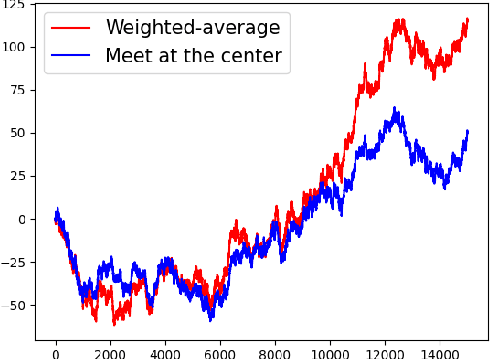
Abstract:The tendency to align to others is inherent to social behavior, including in animal groups, and flocking in particular. Here we introduce the Stochastic Alignment Problem, aiming to study basic algorithmic aspects that govern alignment processes in unreliable stochastic environments. Consider n birds that aim to maintain a cohesive direction of flight. In each round, each bird receives a noisy measurement of the average direction of others in the group, and consequently updates its orientation. Then, before the next round begins, the orientation is perturbed by random drift (modelling, e.g., the affects of wind). We assume that both noise in measurements and drift follow Gaussian distributions. Upon receiving a measurement, what should be the orientation adjustment policy of birds if their goal is to minimize the average (or maximal) expected deviation of a bird's direction from the average direction? We prove that a distributed weighted-average algorithm, termed W , that at each round balances between the current orientation of a bird and the measurement it receives, maximizes the social welfare. Interestingly, the optimality of this simple distributed algorithm holds even assuming that birds can freely communicate to share their gathered knowledge regarding their past and current measurements. We find this result surprising since it can be shown that birds other than a given i can collectively gather information that is relevant to bird i, yet not processed by it when running a weighted-average algorithm. Intuitively, it seems that optimality is nevertheless achieved, since, when running W , the birds other than i somehow manage to collectively process the aforementioned information in a way that benefits bird i, by turning the average direction towards it. Finally, we also consider the game-theoretic framework, proving that W is the only weighted-average algorithm that is at Nash equilibrium.
The Dependent Doors Problem: An Investigation into Sequential Decisions without Feedback
Apr 20, 2017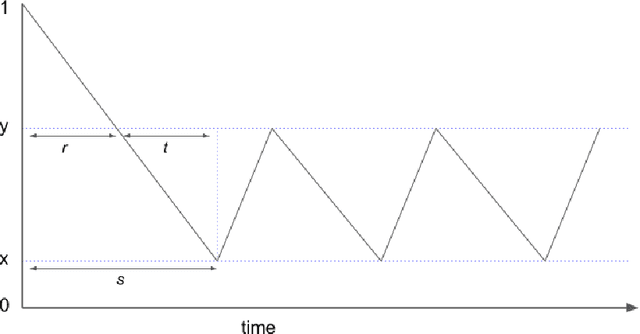
Abstract:We introduce the dependent doors problem as an abstraction for situations in which one must perform a sequence of possibly dependent decisions, without receiving feedback information on the effectiveness of previously made actions. Informally, the problem considers a set of $d$ doors that are initially closed, and the aim is to open all of them as fast as possible. To open a door, the algorithm knocks on it and it might open or not according to some probability distribution. This distribution may depend on which other doors are currently open, as well as on which other doors were open during each of the previous knocks on that door. The algorithm aims to minimize the expected time until all doors open. Crucially, it must act at any time without knowing whether or which other doors have already opened. In this work, we focus on scenarios where dependencies between doors are both positively correlated and acyclic.The fundamental distribution of a door describes the probability it opens in the best of conditions (with respect to other doors being open or closed). We show that if in two configurations of $d$ doors corresponding doors share the same fundamental distribution, then these configurations have the same optimal running time up to a universal constant, no matter what are the dependencies between doors and what are the distributions. We also identify algorithms that are optimal up to a universal constant factor. For the case in which all doors share the same fundamental distribution we additionally provide a simpler algorithm, and a formula to calculate its running time. We furthermore analyse the price of lacking feedback for several configurations governed by standard fundamental distributions. In particular, we show that the price is logarithmic in $d$ for memoryless doors, but can potentially grow to be linear in $d$ for other distributions.We then turn our attention to investigate precise bounds. Even for the case of two doors, identifying the optimal sequence is an intriguing combinatorial question. Here, we study the case of two cascading memoryless doors. That is, the first door opens on each knock independently with probability $p\_1$. The second door can only open if the first door is open, in which case it will open on each knock independently with probability $p\_2$. We solve this problem almost completely by identifying algorithms that are optimal up to an additive term of 1.
Fast Rendezvous on a Cycle by Agents with Different Speeds
Sep 13, 2015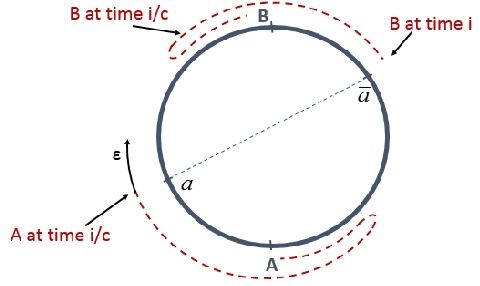
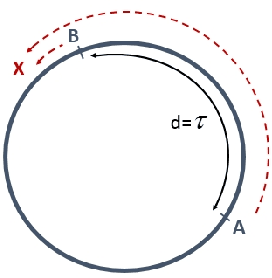
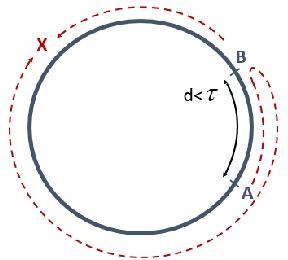
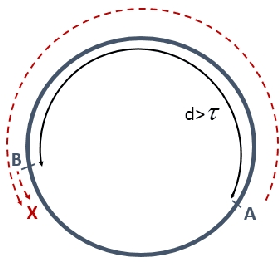
Abstract:The difference between the speed of the actions of different processes is typically considered as an obstacle that makes the achievement of cooperative goals more difficult. In this work, we aim to highlight potential benefits of such asynchrony phenomena to tasks involving symmetry breaking. Specifically, in this paper, identical (except for their speeds) mobile agents are placed at arbitrary locations on a cycle of length $n$ and use their speed difference in order to rendezvous fast. We normalize the speed of the slower agent to be 1, and fix the speed of the faster agent to be some $c>1$. (An agent does not know whether it is the slower agent or the faster one.) The straightforward distributed-race DR algorithm is the one in which both agents simply start walking until rendezvous is achieved. It is easy to show that, in the worst case, the rendezvous time of DR is $n/(c-1)$. Note that in the interesting case, where $c$ is very close to 1 this bound becomes huge. Our first result is a lower bound showing that, up to a multiplicative factor of 2, this bound is unavoidable, even in a model that allows agents to leave arbitrary marks, even assuming sense of direction, and even assuming $n$ and $c$ are known to agents. That is, we show that under such assumptions, the rendezvous time of any algorithm is at least $\frac{n}{2(c-1)}$ if $c\leq 3$ and slightly larger if $c>3$. We then construct an algorithm that precisely matches the lower bound for the case $c\leq 2$, and almost matches it when $c>2$. Moreover, our algorithm performs under weaker assumptions than those stated above, as it does not assume sense of direction, and it allows agents to leave only a single mark (a pebble) and only at the place where they start the execution. Finally, we investigate the setting in which no marks can be used at all, and show tight bounds for $c\leq 2$, and almost tight bounds for $c>2$.
 Add to Chrome
Add to Chrome Add to Firefox
Add to Firefox Add to Edge
Add to Edge